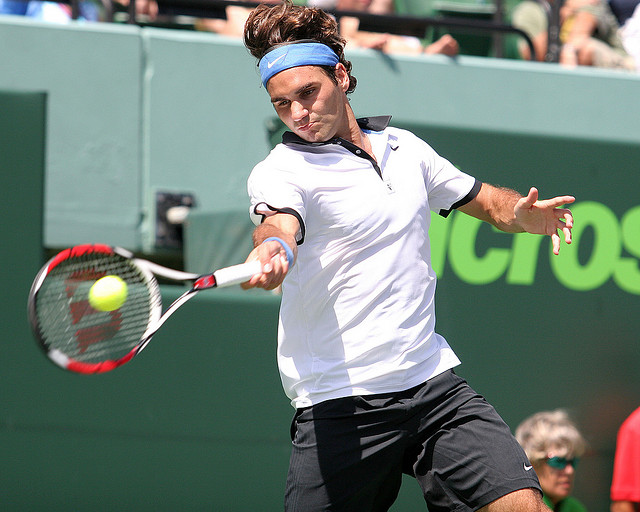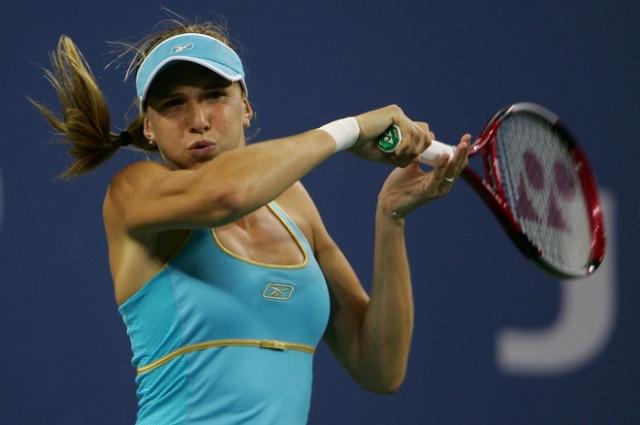How To Feel The Correct Racket Path For Forehand And Backhand Groundstrokes
When we talk about the racket path of the tennis forehand and backhand groundstrokes to tennis beginners, having them to visualize the racket head's path for the forehand and backhand groundstrokes is easier than just verbal instructions. However if they are able to feel the racket path and do it correctly, that is even more useful!
The video below by Tomaz Mencinger is an ideal example of an easy drill you can perform to improve the path of your racket during the groundstrokes. You will be able to see the exact movements your body needs to make through the videos.
Tips to Remember about the Racket Path Drill
You should first understand to use both hands on the racket, as stated in the video, to be able to feel the path of your racket. Using two hands to hold your racket (one on the handle and one on the top of the head of the racket) makes you properly follow through with your racket at the point of contact and beyond. This approach energizes your legs, because you will need to drive in an upward direction from the ground to provide the necessary force for the ball.
Once you have perfected the forehand and backhand using two hands, then try to do them again with the correct racket path using only one hand. First, you should create a stiff swing because you don't need a backswing and in this step, you do not want a follow-through.
Slowly perform this exercise, and concentrate only on your racket. Do not worry about the ball. Yes, your stroke will seem very stiff, but remember it is just an exercise. After you are confident that you understand the proper racket path, then attempt to swing your racket in the exact manner with just one of your hands.
After you can perform the forehand and backhand groundstrokes adequately, then add more force behind them before contacting the ball. This can be done by turning the shoulders and lowering your body. Also, add a follow-through on point of contact, thinking about the right path for your racket head.
A follow-through is simply the act of letting your movement continue through your point of contact instead of it coming to an abrupt halt at the ball.
Note: A follow-through simply happens, when you let your muscles relax once the racket hits the ball.
Now, just do these steps over and over again, when you are trying to find the right tension and comfort with your follow-through. When you attempt to perform the racket path in an ideal manner using conscious movement of your arms and body, this is counterproductive to making your movements as smooth as possible.
It is quite important for this reason to have a clear mental image of the correct path for your racket during your stroke, as you are performing the full forehand and backhand groundstrokes. You have to let your arms and body move unhampered through the point of contact making sure you do not slow your racket or your arms down while doing your stroke.
It takes time for you to get your body to do what your mind has learned. Through performing this drill over time, you will embed the knowledge into your subconscious mind, as well as your conscious mind and this is what allows the proper way to do the groundstrokes become very natural to do.
The Right Way to Practice
Below you will see an easy-to-follow guide for practicing your drill on racket path for both your forehand and backhand groundstrokes:
1. Place one hand on the racket handle and the other one on the top of racket head. Have a friend to toss the tennis balls such that the ball lands in front of you. Practice pushing the tennis ball forward. Next, practice pushing and rolling the tennis ball upwards.
2. Now, use only one hand to control your racket and recreated the recommended racket path for both backhand and forehand strokes making sure there is no backswing at this time or follow-through motion.
3. The backswing can now be added by turning your shoulders and shifting the weight on your legs. At this point, you are still making the conscious effort to move your racket into and through the projected point of contact. This move will be stiff. In addition, allow the racket to follow through the point of contact, while keeping the correct position of the racket head.
4. Now, switch approaches and quit doing the conscious movements, and mentally picture how to do the same movements. Think about the slow motion clips shown in the above videos. This is a very important practice step.
5. You need to work on making a relaxed stroke. Also, be thinking about where the racket needs to go throughout its path as you practice the stroke.
6. In the end, you will be able to combine the concept of compress and roll with your mental imagery of the path.
Learn more information that is useful for beginners.


New! Comments
Have your say about what you just read! Leave me a comment in the box below.